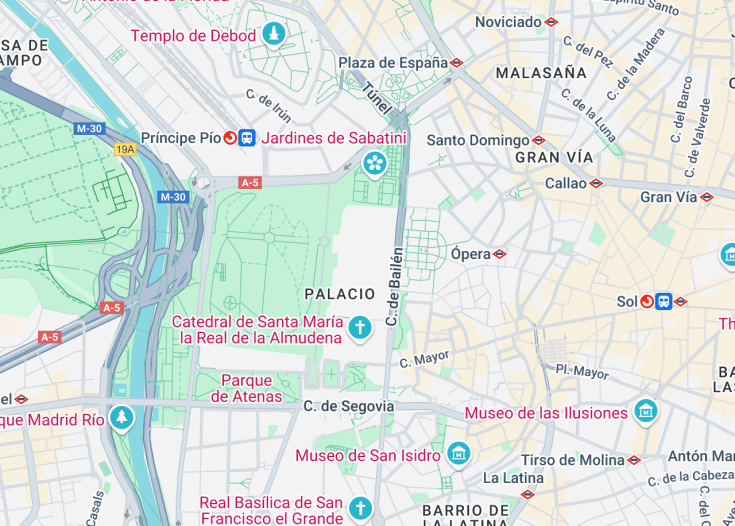The Royal Palace of Madrid, the largest royal palace in Western Europe, serves as the official residence of the Spanish Royal Family. Located in the heart of the Spanish capital, this majestic building stands out not only for its imposing size but also for its rich history and artistic significance. The palace boasts over 3,400 rooms decorated with treasures from around the world, including artworks by Velázquez and Goya, making it a highlight for tourists and a symbol of Spain’s cultural legacy.
When visiting, remember to check the opening hours and any special events, as parts of the palace may be closed to the public during official ceremonies.
To make the most of your visit, consider joining a guided tour to gain deeper insights into the palace’s history and the many artworks it houses.
The Splendor of the Royal Palace of Madrid
The Royal Palace of Madrid, known as Palacio Real, is a monumental structure that serves as the official residence of the Spanish Royal Family, though it is now used primarily for state ceremonies. Situated on the site of a 9th-century fortress, the current palace was constructed in the 18th century and exemplifies classical Baroque architecture. As the largest royal palace in Europe based on floor area, and with over 3,000 ornate rooms, including the stunning Throne Room and the opulent Hall of Mirrors, the palace stands as a testament to the lavish tastes of Spain’s past monarchs.
Its rich decor, comprising priceless artworks by Caravaggio, Velázquez, and Goya, among others, not only emphasizes the cultural grandeur of Spain but also attracts tourists from around the globe. The palace’s exterior is just as magnificent, surrounded by the beautifully manicured Gardens of Sabatini and Campo del Moro, offering visitors a splendid view that extends across the royal property. A tour through this exquisite palace is a journey through Spanish history, showcasing royal life, splendor, and artistry unparalleled in Europe.
Exploring the grandeur: key attractions
The Royal Palace of Madrid is not only a historical edifice but a treasure trove of art and culture. Visitors can marvel at the intricate details in the Main Staircase, designed by Sabatini, which sets the tone for the opulent adventure within. The Royal Armory, one of the most significant collections of its kind worldwide, features armor and weaponry dating back to the 13th century.
For art lovers, the palace houses an exhaustive collection of classical art by prominent artists such as Velázquez, Goya, and Caravaggio, along with frescoes adorning the palace ceilings created by Tiepolo. The Palace Gardens, including the Sabatini and Campo del Moro, are perfect for a serene walk after exploring the rich interiors. These attractions make the Royal Palace not just a historical stop but a holistic experience of Spain’s regal past and artistic heritage.
The Stradivarius Room: A resonance of history
The Royal Palace holds a unique appeal for music enthusiasts, particularly in its renowned Stradivarius Room. This room houses a priceless collection of Stradivari instruments, one of the few such collections in the world, which includes two violins, a viola, and a cello, collectively known as the Palatine Quartet.
Crafted in the 17th century by Antonio Stradivari, these instruments are famed for their extraordinary sound quality and exquisite craftsmanship. Historically, they were part of the Spanish Royal Collection and symbolize the royal family’s long-standing patronage of the arts and music. This room is not just a display of musical instruments but a chamber of auditory history that has withstood the test of centuries, echoing the sophisticated cultural pursuits of the Spanish monarchy.
Explore the grandeur of the royal palace of madrid
The Royal Palace of Madrid is a splendid destination suited for visitors of all ages, including families, history buffs, and architecture enthusiasts. Guests can expect a journey through opulent rooms, historic artifacts, and stunning art collections that tell tales of Spain’s rich monarchic past.
The best time to visit the royal palace of madrid
Visiting during the late spring and early fall is ideal as the weather is pleasant, avoiding Madrid’s harsh summers and cold winters. During these seasons, the palace gardens bloom beautifully providing a spectacular view.
Annual events
Consider visiting during national holidays such as King’s Day (January 6) when unique ceremonies might be witnessed.
Accessibility and limitations at the royal palace
Accessibility
Limitations
- Photography Restrictions
- No Large Bags or Backpacks
- Security Checkpoints
Close the shortcode with
Notes
- Some rooms may not be accessible due to ongoing preservation efforts.
- Audio guides are available in multiple languages to enhance the touring experience.
Close the shortcode with
General information
Details for your visit to Royal Palace of Madrid
Location
The Royal Palace is centrally located, near significant landmarks such as Plaza Mayor and the Almudena Cathedral.
Address: Calle de Bailén, s/n, 28071 Madrid, Spain
Opening hours
The palace is open from 10 am to 6 pm during winters and extends until 8 pm in summers. It is closed on major public holidays.
Getting to the royal palace of madrid
Car
Reaching the palace by car is convenient with several parking spaces available around the area.
| Route | Distance | Travel time |
|---|---|---|
| From Madrid Airport | 20 km | 30 minutes |
| From Cobendas | 29 km | 35 minutes |
Public Transport
Several metro and bus lines stop near the palace, making it easily accessible from different parts of the city.
Nearby attractions
List of nearby attractions sorted by proximity:
- Almudena Cathedral – 0.4 km (0.25 mi)
- Plaza Mayor – 0.5 km (0.31 mi)
- Prado Museum – 1.2 km (0.75 mi)
- El Retiro Park – 1.5 km (0.93 mi)
- Santiago Bernabeu Stadium – 4.1 km (2.54 mi)
- Reina Sofia Museum – 2.2 km (1.36 mi)
Common questions
What is the historical significance of the Royal Palace of Madrid?
Can you explore the interiors of the Royal Palace of Madrid, and what can you see inside?
What are the architectural styles represented in the Royal Palace of Madrid?
Are there guided tours available at the Royal Palace of Madrid?
What unique items are housed in the Royal Armory of the Royal Palace of Madrid?
How does the Royal Palace of Madrid compare with other European royal palaces?
What is the role of the Royal Palace of Madrid in modern Spanish society?
What conservation efforts are in place for the Royal Palace of Madrid?

Is the royal palace of madrid worth visiting?
The Royal Palace of Madrid offers a deep dive into Spain’s regal history and architecture, making it a potentially valuable stop for tourists interested in these aspects. The palace, known for its lavish interior and expansive art collection, provides insight into the lives of the Spanish monarchy. It spans an impressive area, featuring over 3,000 ornately decorated rooms that showcase the luxury and style of past centuries.
However, for some visitors, the palace might seem overwhelming due to its vast size and the sheer volume of exhibit items. While art enthusiasts and history buffs will find plenty to appreciate, those seeking a more casual or interactive experience might find it less engaging. Accessibility and the cost of entry, coupled with possible crowd hassles, could deter some potential visitors.










